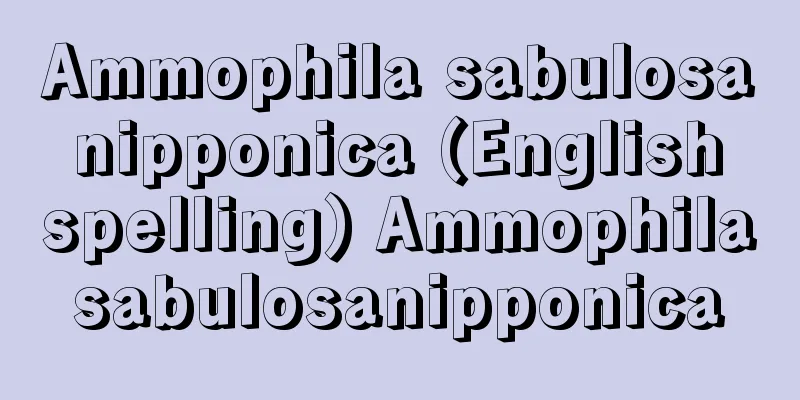Tsukudani - Food boiled in soy sauce

|
A processed food made from small fish, shrimp, shellfish, seaweed, vegetables, etc. as main ingredients, simmered with seasonings mainly consisting of soy sauce, and then preserved. [Tomomi Kono and Midori Otaki] historyIn the early Edo period, fishermen from Tsukuda Village in Settsu (Tsukuda, Nishiyodogawa Ward, Osaka City) moved to a small island near Ishikawajima in Edo, named it Tsukuda Island after the name of their hometown, and engaged in fishing. Tsukuda Village was originally a small fishing village called Tamino Village, and the fishermen were very favored by Tokugawa Ieyasu for providing boats for him when he made pilgrimages to Tada Shrine in Settsu Province (Tada Shrine, Kawanishi City, Hyogo Prefecture) and for helping Ieyasu during the Siege of Osaka, and were given permanent fishing rights, which means the privilege of being able to fish anywhere in the country tax-free. The name Tsukuda was also given to them by Ieyasu. In gratitude for Ieyasu's reward, the fishermen of Tsukuda presented fish to Edo once a year. However, it was a hard job to travel to Edo every year, so he asked to move there, and Ieyasu readily agreed, giving him Tsukuda Island (Tsukuda, Chuo Ward, Tokyo) at the mouth of the Sumida River. The fish they caught were delivered to Edo Castle and to feudal lords. The remaining small fish were boiled in seasonings to make a prepared meal for home use, but because it was easy to preserve and inexpensive, they began to be sold in the Tsukudajima area, and it came to be called tsukudani because it was made in Tsukudajima. Tsukudani also spread throughout the country as an Edo specialty when samurai from all over the country brought it back as a souvenir when they returned home in shifts. [Tomomi Kono and Midori Otaki] kindsOriginally, small fish were used, but as sales expanded and tsukudani began to be made in various places, various things began to be used as ingredients. The main ingredients used today are fish such as bonito, tuna, smelt, goby, gori, icefish, small crucian carp, sand lance, whitebait, and small sweetfish, shellfish such as asari clams, mussels, shijimi clams, ark shells, and oysters, dried marine products such as dried squid, small dried fish, dried shellfish, dried shrimp, dried cod, kelp, and nori, other marine products such as mys and shrimp, and plant-based products such as butterbur, leaf chili peppers, Japanese pepper, shimeji mushrooms, shiitake mushrooms, and matsutake mushrooms. Tsukudani was originally made by simmering in soy sauce, but recently many have been made with sweeter ingredients, with more added sugar. Fresh ingredients are thoroughly washed in water, drained, and placed in boiling seasoning liquid, then slowly simmered over low heat. The water in the ingredients is replaced by the more concentrated seasoning liquid, improving storage life. Other types of tsukudani include shigureni, in which shellfish are simmered in soy sauce containing ginger and Japanese pepper, and kanroni (also called candied food), in which shellfish are simmered in soy sauce with plenty of mizuame (starch syrup), mirin, sugar, and other ingredients until all the liquid has evaporated. Shigureni clams simmered in tamari soy sauce are famous specialties of Kuwana, Mie Prefecture, candied small sweetfish in Shiga Prefecture, and tsukudani gori in Ishikawa Prefecture. [Tomomi Kono and Midori Otaki] nutritionSmall fish that can be eaten with the bones are a good source of protein, calcium, phosphorus, etc. However, they contain a lot of salt, so people with high blood pressure should be careful. Recently, low-salt tsukudani has also become available. [Tomomi Kono and Midori Otaki] It is made by boiling river fish, mainly gobies, with sweetened candy and sugar. ©Shogakukan "> Gori candied fish ©Shogakukan "> Sweetened simmered yamame trout ©Shogakukan "> Braised clams in miso soup (misotsu hamaguri) Source: Shogakukan Encyclopedia Nipponica About Encyclopedia Nipponica Information | Legend |
|
小魚、小エビ、貝、海藻、野菜などをおもな原料として、しょうゆを主とした調味料で煮つめ、保存を目的とした加工食品。 [河野友美・大滝 緑] 歴史江戸時代の初期、摂津の佃村(大阪市西淀川(よどがわ)区佃)の漁民が、江戸・石川島の近くの小島に移住し、出身地の地名から佃島と名づけて漁業に従事していた。もともと佃村は田蓑(たみの)村という小さな漁村であり、漁民たちは、徳川家康が摂州多田廟(びょう)(兵庫県川西市多田神社)へ参詣(さんけい)するときに船で渡したり、また大坂の陣のときに家康を助けたことなどから家康にたいへん優遇され、永世漁業権、つまり無税で全国どこででも漁業ができる特権を与えられた。佃という名前も家康から与えられたものである。佃の漁民は家康の恩賞に感謝し、年に一度江戸へ魚を献上していた。しかし毎年江戸まで行くのはたいへんなので、江戸へ移住したい旨申し出ると、家康は快諾し、隅田川河口の佃島(東京都中央区佃)を与えたという。 とれた魚は江戸城中や諸侯へ納めていた。残りの小さな雑魚(ざこ)は調味料で煮つめて自家用の総菜としていたが、保存がきき、値段も安くできるところから、佃島の近辺でも販売を始めるようになり、佃島でつくるので佃煮とよばれるようになった。佃煮はさらに、諸国の侍たちが交代で帰国する際、土産(みやげ)物として持ち帰ったところから、江戸名物として全国に広まるようになった。 [河野友美・大滝 緑] 種類もともとは小魚類を用いていたが、販路が伸び、各地でも佃煮がつくられるようになって、いろいろのものが原料として用いられるようになった。現在用いられているおもな材料は、魚類としては、カツオ、マグロ、ワカサギ、ハゼ、ゴリ、シラウオ、小ブナ、イカナゴ、シラス、小アユなど、貝類として、アサリ、ハマグリ、シジミ、アカガイ、カキなど、乾燥水産物として、するめ、干し小魚、干し貝類、干しえび、干しだら、昆布、海苔(のり)など、そのほか水産物としてアミ、エビなど、植物性のものとして、フキ、葉トウガラシ、サンショウ、シメジ、シイタケ、マツタケなどである。 佃煮は元来、しょうゆで煮つめたものがおもであったが、最近は糖類を多く加えた甘味のあるものが多くなった。新鮮な材料を水でよく洗い、水けをきって煮立てた調味液の中に入れ、弱火でゆっくりと煮つめる。材料中の水分が濃度の濃い調味液と入れ替わることにより貯蔵性が高まる。貝類を、ショウガ、サンショウなどを加えたしょうゆで煮つめた時雨(しぐれ)煮、しょうゆのほかに水飴(みずあめ)やみりん、砂糖などをたっぷり使って汁気がなくなるまで煮つめた甘露(かんろ)煮(飴煮ともいう)も佃煮の一種である。溜(たまり)しょうゆで煮つめたハマグリの時雨煮は三重県桑名の、小アユの飴煮は滋賀県の、ゴリの佃煮は石川県の、それぞれ名産として名高い。 [河野友美・大滝 緑] 栄養骨ごと食べられる小魚では、タンパク質、カルシウム、リンなどの補給源となる。しかし、食塩含有量が高いので、高血圧症などの人は注意を要する。最近は塩分を控えた減塩の佃煮も現れている。 [河野友美・大滝 緑] おもにハゼ類の川魚を使い、飴と砂糖を加えて煮たもの©Shogakukan"> ゴリの飴煮 ©Shogakukan"> ヤマメの甘露煮 ©Shogakukan"> ハマグリの時雨煮(時雨はまぐり) 出典 小学館 日本大百科全書(ニッポニカ)日本大百科全書(ニッポニカ)について 情報 | 凡例 |
Recommend
Taiwan Governor's Office
This was the colonial administrative agency for J...
Trilobite - Sanyochu (English spelling)
A marine fossil animal belonging to the arthropod...
Totsukawa
A river that flows through southern Nara Prefectu...
Isolated point
(1) Let S be a topological space, M be a subset of...
Karrenfeld; lapies field
Limestone pillars measuring tens of centimeters to...
Caribbean Policy
The policy of the United States to maintain influe...
montaña (English spelling) montana
…From the colonial period to the present day, Ind...
Karies (place name) - Karies
…Even after the collapse of the Byzantine Empire,...
Cutting edge
〘Noun〙① = kiriha (cutting edge)② A cut in a Joruri...
Doan Thi Diem (English spelling)
…The author, who lived in an era when Vietnam was...
Sho Tai
Year of death: August 19, 1901 (Meiji 34) Year of ...
Lump - Bump
1. A condition in which the skin is raised high du...
Received Standard
…The introduction of printing in the late 15th ce...
Alamūt (English spelling)
An Assassin fortress built on a steep rocky mounta...
Oppolzer, E. (English spelling) OppolzerE
…Austrian astronomer. Born in Prague, he studied ...









